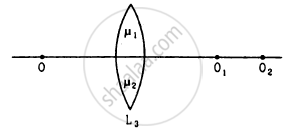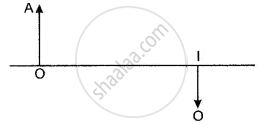Advertisements
Advertisements
Question
Consider three converging lenses L1, L2 and L3 having identical geometrical construction. The index of refraction of L1 and L2 are \[\mu_1 \text{ and } \mu_2\] respectively. The upper half of the lens L3 has a refractive index \[\mu_1\] and the lower half has \[\mu_2\] following figure . A point object O is imaged at O1 by the lens L1 and at O2 by the lens L2placed in same position. If L3 is placed at the same place,
(a) there will be an image at O1
(b) there will be an image at O2.
(c) the only image will form somewhere between O1 and O2
(d) the only image will form away from O2.
Solution
(a) there will be an image at O1
(b) there will be an image at O2
The lens L1 converges the light at point O1 and lens L2 converges the light at O2. As the upper half of lens L3 has a refractive index equal to that of L1, it will converge the light at O1 and thus the image will be formed at O1. Also, the lower half of lens L3 has a refractive index equal to that of lens L2, it will converge the light at O2 and thus the image will be formed at O2.
APPEARS IN
RELATED QUESTIONS
What is meant by a power of a lens? Define its SI unit.
What does sign of power (+ve or –ve) indicate?
A convex lens forms a real and inverted image of a needle at a distance of 50 cm from it. Where is the needle placed in front of the convex lens if the image is equal to the size of the object? Also, find the power of the lens.
You have two lenses A and B of focal lengths +10 cm and –10 cm, respectively. State the nature and power of each lens. Which of the two lenses will form a virtual and magnified image of an object placed 8 cm from the lens? Draw a ray diagram to justify your answer
The lens mentioned in 6(b) above is of focal length 25cm. Calculate the power of the lens.
Which type of lens has (a) a positive power, and (b) a negative power?
The power of a lens is, −2 D. What is its focal length?
Fill in the following blank with suitable words :
The reciprocal of the focal length in metres gives you the _________ of the lens, which is measured in ___________.
The power of a lens is + 1.0 D is :
Express the power (with sign) of a concave lens of focal length 20 cm.
Find the radius of curvature of the convex surface of a plano-convex lens, whose focal length is 0.3 m and the refractive index of the material of the lens is 1.5.
A symmetric double convex lens in cut in two equal parts by a plane perpendicular to the principal axis. If the power of the original lens was 4 D, the power a cut-lens will be
A diverging lens of focal length 20 cm and a converging lens of focal length 30 cm are placed 15 cm apart with their principal axes coinciding. Where should an object be placed on the principal axis so that its image is formed at infinity?
The power of a lens is +2.0 D. Find its focal length and state the kind of lens.
The following diagram shows the object O and the image I formed by a lens. Copy the diagram and on it mark the positions of the lens LL’ and focus (F). Name the lens.

If focal length of a convex lens is 20 cm at what is the power of the lens?
Define power of a lens. What is its unit? One student uses a lens of focal length 50 cm and another of –50 cm. What is the nature of the lens and its power used by each of them?
An object is kept at a distance of 1m from a lens of power +2D:
- Identify the type of lens.
- Calculate its focal length and distance of the image formed.
